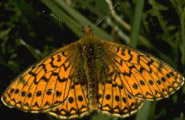Native Plants
Search for native plants by scientific name, common name or family. If you are not sure what you are looking for, try the Combination Search or our Recommended Species lists.
Gaultheria hispidula
Gaultheria hispidula (L.) Muhl. ex Bigelow
Creeping Snowberry, Creeping-snowberry
Ericaceae (Heath Family)
Synonym(s): Chiogenes hispidula
USDA Symbol: GAHI2
USDA Native Status: L48 (N), CAN (N), SPM (N)
A creeping, matted, delicate evergreen shrub, 6 in. high. The leafy, somewhat woody stems and underside of the leaves are covered in bristly hairs. The flowers are translucent white, shallow bells with the four petals giving an almost square shape no more than 3mm across. Flowers are followed by bright, white fruit, much larger than the flowers and tasting of wintergreen.
Plant Characteristics
Duration: PerennialHabit: Shrub
Leaf Retention: Evergreen
Leaf Complexity: Simple
Fruit Type: Capsule
Size Notes: Up to about 6 inches tall.
Leaf: Dark Green
Bloom Information
Bloom Color: WhiteBloom Time: Apr , May , Jun , Jul , Aug
Distribution
USA: CT , ID , MA , MD , ME , MI , MN , NH , NJ , NY , OH , PA , RI , VT , WA , WI , WVCanada: AB , BC , MB , NB , NL , NS , ON , PE , QC , SK
Native Distribution: Lab. to B.C., s. to NJ, WV, MI, MN & n. ID
Native Habitat: Bogs; swamps; mossy, conifer woods
Growing Conditions
Water Use: MediumLight Requirement: Shade
Soil Moisture: Moist , Wet
Soil pH: Acidic (pH<6.8)
CaCO3 Tolerance: Low
Soil Description: Cold, acid soils.
Conditions Comments: A suitable ground cover for cold, shady, acid sites.
Benefit
Conspicuous Flowers: yesAttracts: Butterflies
Larval Host: Bog Fritillary (Boloria eunomia)
Butterflies and Moths of North America (BAMONA)
|
Bog Fritillary (Boloria eunomia)  Larval Host |
Propagation
Description: The prostrate stems are practically all rooted at intervals along their length. These natural layers can be separated in the fall and planted in peat. Always keep shaded.Commercially Avail: yes
Mr. Smarty Plants says
Groundcover to reduce erosion for shady area in New York
May 05, 2009
We live on a lake with gravelly and clay soils, lots of wind and little sun. I am looking for a native ground cover that will help reduce erosion over some of the steep slopes facing south (under shad...
view the full question and answer
Native plants to stop pond bank erosion
June 04, 2008
I recently purchased a home with a small pond in which a nearby stream daylights. The former owner placed large field stone around the pond and the small stream; however, the area around the pond and...
view the full question and answer
National Wetland Indicator Status
| Region: | AGCP | AK | AW | CB | EMP | GP | HI | MW | NCNE | WMVE |
| Status: | FACW | FACW | FACW | FACW | FACW |
Bibliography
Bibref 1186 - Field Guide to Moths of Eastern North America (2005) Covell, C.V., Jr.Bibref 1185 - Field Guide to Western Butterflies (Peterson Field Guides) (1999) Opler, P.A. and A.B. Wright
Search More Titles in Bibliography
Web Reference
Webref 38 - Flora of North America (2019) Missouri Botanical Garden, St. Louis, MO & Harvard University Herbaria, Cambridge, MA.Webref 23 - Southwest Environmental Information Network (2009) SEINet - Arizona Chapter
Additional resources
USDA: Find Gaultheria hispidula in USDA PlantsFNA: Find Gaultheria hispidula in the Flora of North America (if available)
Google: Search Google for Gaultheria hispidula
Metadata
Record Modified: 2023-02-10Research By: TWC Staff